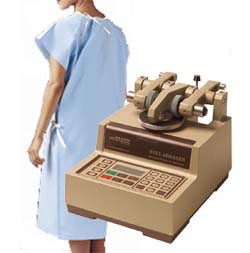Nonwovens
Customizing a Test Procedure Reveals More Meaningful Data
Situation:
A leading manufacturer of nonwoven materials requires abrasion tests as part of their quality acceptance criteria. Despite following an internationally recognized test method, they were having difficulty obtaining consistent abrasion test results and contacted Taber Industries for our expert opinion.
Analysis:
The customer used the Taber® Rotary Abraser (Abrader) to test their materials and was following a procedure based on ASTM D3884. Abrasion resistance was evaluated with a visual inspection of the test specimen after a specified number of abrasion test cycles.
 It was initially thought much of the test variation was caused by the evaluation technique. As was explained to the customer, when evaluating specimens visually there is significant room for interpretation differences depending on lighting conditions, operator influence, test procedures, and other factors. Therefore, Taber's investigation was centered on determining whether an alternative means of measurement (e.g. quantitative -weight loss method) could be employed to rank the performance of the nonwoven materials.
It was initially thought much of the test variation was caused by the evaluation technique. As was explained to the customer, when evaluating specimens visually there is significant room for interpretation differences depending on lighting conditions, operator influence, test procedures, and other factors. Therefore, Taber's investigation was centered on determining whether an alternative means of measurement (e.g. quantitative -weight loss method) could be employed to rank the performance of the nonwoven materials.
During preliminary testing, it became evident that the wheel selection and applied load played a significant role in the variation present. The customer specified Taber's resilient Calibrase® wheels with a load of 1000g per wheel. The wheels are designed such that the binder breaks down with use, exposing fresh abradant materials during the test. Although the Taber Abraser (Abrader) employs a vacuum system to remove worn materials generated during the test, the nonwoven product has an open structure which allows debris to become trapped between the nonwoven fibers. This leads to interference with the visual analysis and will affect a weight loss measurement.
Additional experiments were carried out using a variety of load and abrading wheel combinations to determine which would be most suitable for the abrasion testing of nonwoven materials. It was determined that the Calibrade® H-10 Wheels under a load of 250g per wheel provided the most realistic and repeatable data.
Benefit:
After implementing the recommended changes to their testing protocol, the customer demonstrated that the quantitative weight loss results obtained via round robin abrasion testing with the Taber® Rotary Abraser (Abrader) were significantly more consistent than previous visual interpretations of the products’ performance. This allowed the customer to establish tighter parameters for their quality control processes which ultimately lead to a reduction in the number of complaints and returns.


